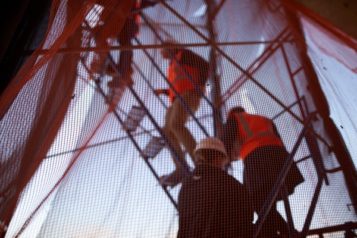
Fall protection is the most frequently cited OSHA violation. And for construction workers, falls are the leading cause of death according to the United States Department of Labor Occupational Safety & Health Administration. In addition, an estimated 2.3 million construction workers, or 65 percent of the construction industry, work on scaffolds.
In a recent Bureau of Labor Statistics study, 72 percent of workers injured in scaffold accidents attributed the accident either to the planking or support giving way, or to the employee slipping or being struck by a falling object. All of these accidents could have been controlled by compliance with OSHA standards (www.osha.gov).
Property developer, builder and owner Lendlease shares its insights with Construction Superintendent on the development and practice of its transparent safety management systems and standards—called Global Minimum Requirements—that provide detailed procedures for how scaffolds, temporary works and working platforms should be employed by superintendents and construction crews on the jobsite to help ensure projects are delivered safely.
- All proprietary systems shall be designed in accordance with the manufacturer’s recommendations.
- The mixing of components from different proprietary systems shall not be permitted between the top of the false-work foundation and the underside of primary members.
- Any calculations and drawings should clearly communicate requirements to those checking and constructing temporary works.
- Designs shall ensure that vertical members are not overloaded.
- Effective measures must be put in place to ensure the safe erection and use of all scaffolds, temporary works and working platforms (including mobile and tower scaffolds) which ensure that the work is planned and conducted in accordance with the requirements for high risk activities as outlined by the GMRs.
- All scaffolds must be fit for intended use, with all structural members free from visible defects.
- All scaffolds must be stable and secure to prevent movement and collapse.
- Scaffolds must be plumb, have adequate cross-bracing, sound footings and be tied into structure where height/base ratio is greater than 3:1.
- Stairs should be provided to enable safe access on scaffolds.
- Stairs and/or ladders must be progressively installed as the scaffold is erected to provide safe access and egress to the installers/scaffolders. Where these are not practical, safe inclined ladder or appropriate ramp access must be provided. Rest stations should be provided if required.
- All access/landing points at different levels of the scaffold must be designed to minimize the potential for falls.
- Where ladders are used for access, safe means of transporting tools and materials up the scaffold must be provided. Climbing up the outside of scaffolds must be prohibited.
- Working platforms must be closely boarded or planked, which must be free from defects.
- Any damaged boards or planks, debris, materials and waste must be removed from scaffolds as soon as is practical.
- Guard rails, mid-rails and toe boards must be installed on all open sides of platforms from which people or materials may fall. Where there is a risk of materials falling over toe boards, means of preventing materials falling must be provided, e.g. netting or fencing.
- Where there is a risk of dusts, liquids or small objects arising from works on scaffolds creating risks to workers or the public, additional precautions, such as plastic nets/sheeting, must be installed.
- Mobile tower scaffolds must be fitted with top guardrails, mid rails and toe boards, as well as a safe means of internal access to the work platform. Mobile tower scaffolds must also have a covered hatch in the platform to allow safe access and lockable wheels which must be locked to prevent movement at all times when persons are on the scaffold.
- No person is permitted to remain on a scaffold tower platform while it is being moved.
- All loading platforms must be assessed before installation and regularly inspected by a competent person.
- They must be fitted with guard rails on all sides, including on the front/exposed edge, that prevent falls of people or materials.
- Loading platforms should be arranged so loads can be deposited without removing the guard or creating a risk of falls; for example, by employing gate systems that provide full fall protection.
Protecting workers from scaffold-related accidents may prevent some of the 4,500 injuries and over 60 deaths every year (BLS, 2003 and 2004 data for the private sector) (www.osha.gov). Adopting best practices supported by guidelines on how to comply with these requirements will go a long way toward reducing the number of these scaffold-related accidents and keeping workers safe.
Article submitted by Lendlease. For more info, visit lendlease.com.




 Join our thriving community of 70,000+ superintendents and trade professionals on LinkedIn!
Join our thriving community of 70,000+ superintendents and trade professionals on LinkedIn! Search our job board for your next opportunity, or post an opening within your company.
Search our job board for your next opportunity, or post an opening within your company. Subscribe to our monthly
Construction Superintendent eNewsletter and stay current.
Subscribe to our monthly
Construction Superintendent eNewsletter and stay current.